
Sydney Rows
A Centennial History of the Sydney Rowing Club, 1970, by A L May
Table of Contents
Chapters
- Preliminaries: before 1870
- Foundations: 1870-1880
- New Clubs: 1880-1890
- The Amateur Question: 1890-1900
- Sydney on Top: 1900-1910
- Henley and War: 1910-1920
- Pearce and Mosman: 1920-1930
- Financial Problems: 1930-1940
- War and Wood: 1940-1950
- Strength and Stability: 1950-1960
- On Top Again: 1960-1970
Appendices
5. Sydney on Top: 1900-1910
Lightweight rowing first commenced in NSW in the 1908/09 season. The first event was held by SRC at its annual regatta in October, 1908. The race was for oarsmen 10 stone and under, and Sydney led home a field of five. The winning crew was Harry Pike, S. B. Bailey, R. Philp and Keith Corden (stroke) - the race itself being put on at Corden's suggestion. Other lightweight maiden races were to follow, the first race for points being at the Leichhardt Regatta of November, 1908, which the Sydney crew, with Rabett replacing Corden, also won. Sydney's senior four of Barker, Ryrie, Moesch and Fitzhardinge took the champion fours, also held at the Leichhardt Regatta.
Only Leichhardt opposed Sydney in the champion eights of February, 1909 and Sydney won by 3 lengths, also taking the maiden fours and the junior fours at the regatta. John Towns of Mercantile won the champion sculls once again. Sydney's eight had five "veterans" in Barker, Heron, Moesch, Reid and Fitzhardinge, together with E. W. Marriott, the former Glebe interstate oarsman, and two newcomers in F. P. Kelly and J. Punch.
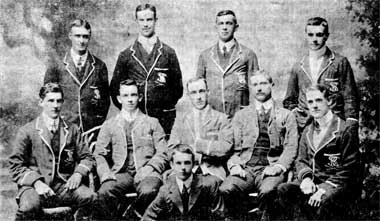
Sydney's champion eight of 1909
Back row (left to right): E W Marriott, J F Reid, F R Heron, J S Punch. Front row: E R Barker, W J Middleton, R B Fitzhardinge, C M Moesch, F P Kelly. On ground: L J Boone. (The club blazer was adopted in 1907.)
The various wins gave Sydney the championship pennant for 1908/09 for the sixth consecutive year with 168 points to Mercantile's 60. The Association introduced a junior pennant for the first time in 1908/ 09 for the club winning the most maiden and junior races in the season. Sydney was the first winner with 40 points to Enterprise's 28.
Fitzhardinge, Ramsay and McGregor selected the NSW crew and Goldie (stroke) and Reid gained places in the crew, with Kelly emergency. Middleton was unavailable to coach and Fitzhardinge himself was among those unavailable to row. Ramsay took on the coaching of the heavy (12 1/2 stone average) crew. In Brisbane, in miserably wet conditions, Tasmania led all the way to toss the Vics by 1 1/2 lengths, with NSW third 3 lengths further back. Only WA was not present. John Towns made amends in the sculls for NSW, with an 8 lengths win.
It was University's turn in the 1909/10 season. They won the champion fours in October, 1909, with Sydney only fourth behind Balmain and Mercantile. The club's maiden eight, coached by Ernie Keary who had transferred from Mercantile in 1908, won at the same regatta. At the club's own regatta the same month, the programme consisted of three open races and only one club race. Sydney rowed second to University in the senior fours, was second to Glebe in the maiden fours and ran into a pleasure skiff in the junior eights.
The champion eights in December went to University, with Balmain 3 lengths back second and Sydney 1/2 length behind third. With schoolteacher John Towns now in Young, Arch Priddle of Balmain emerged as the State's new top sculler. Roger Fitzhardinge was appointed sole State selector and, as the Association's report states, "owing to his influence some of the best men were induced to row". Fitzhardinge chose four University men, including K. B. Gaden, "perhaps, the best man since the time of J. E. Kennedy", who was a son of C. W. Gaden of Sydney and intercolonial fame. Barker and Sid Middleton of Sydney, Hauenstein of Leichhardt and Parkinson of Baimain completed the crew, with Bill Middleton coach once again. H.K. Ward rowed stroke.
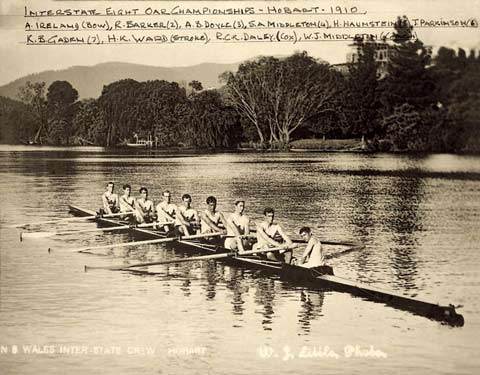
1910 NSW Interstate Crew
The State eight set off for Tasmania with a brand new eight built by George Towns and christened the Q. L. Deloitte. The win of 1908 was repeated, NSW drawing away to beat Victoria by 4 lengths with Tasmania 3 lengths back third. Another Tasmanian, Cecil McVilly, emerged on top in the sculls, beating Ivens of Victoria with Priddle outpaced. Although University had won the premiership, Sydney showed it had some kick left by winning the Gold Cup by 1/2 length from Mercantile. The crew was Rabett (bow), Kelly, Wellesley, Sampson, Scott Punch, Fearby and Barker (stroke).
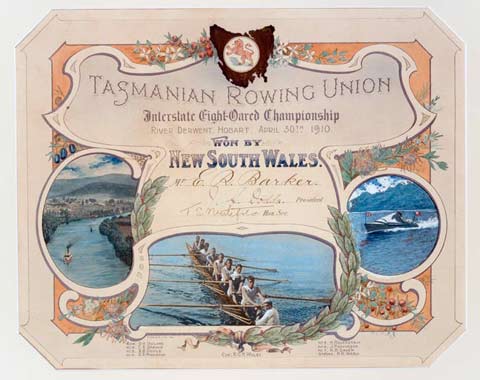
1910 NSW Crew's Winning Certificate
Other Developments
School rowing continued to attract much interest. Shore won the GPS regatta in 1900, St. Ignatius' in 1901 and Grammar, coached by W. H. Savigny, a master of the school who had rowed at Oxford, scored a hat trick from 1902 to 1904. St. Ignatius', coached by Nat McDonald, won easily in 1905, a parade of interstate eights and scullers being a feature of this regatta.
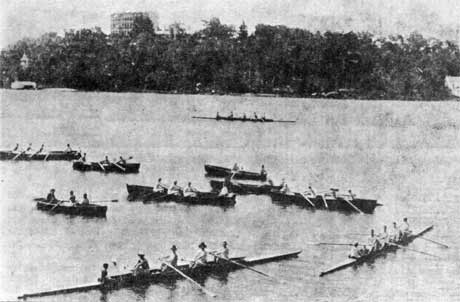
Riverview crews training in 1901
The GPS authorities made an important change in 1906, when open races for clubs were discontinued, lack of support by the clubs in the past being given as the reason for the move. The regatta was thereafter moved to a Wednesday, with a race for second crews being introduced. St. Joseph's boosted the number of competing schools to four in 1907 but Shore continued to have most success, winning the main event in 1906 and 1908. St. Ignatius', coached by Stanbury, the sculler, won in 1907 and Grammar was successful in 1909. In 1910 the main race was rowed in eights for the first time, with Shore, coached by Allan Ramsay, captain of Leichhardt, taking the title.
From about 1905, rowing men had to become used to the idea of rowing by women. Double sculling, in particular, became popular and a ladies' championship was held on the Parramatta in August, 1906. Ten crews entered with Mesdames Woodbridge and Hyde of Newcastle winning the £20 prize. Mrs. Woodbridge was, soon after, challenged by Miss Gertrude Lewis of Middle Harbour to a race for ₤25 a side and the ladies' sculling championship of Australia. The race took place in February, 1907 with Miss Lewis winning easily. She repeated her success for the same stake and honours over Mrs. Hyde in August, 1909. A number of other events for ladies were held at various regattas.
The NSW Rowing Association was involved in some very significant developments during the decade. In July, 1901, it finally succeeded in getting a sufficient number of members of its Council together to disband itself, its powers reverting to the committee of the Association. The general meeting of 1902 confirmed the arrangement and laid down that alterations to the rules must first be submitted to committee meetings and a 2/3 majority be found to be in favour. A sub-committee to revise the Association's rules was set up in February, 1902.
While it was working, renewed efforts to allow manual labourers to row as amateurs were being made. A motion put forward by John Symington, captain of Balmain and secretary of the RA, to this effect gained 10 votes to 9 against, but not a twothirds majority. Sydney's annual meeting in August, 1902, instructed its delegates to oppose any attempt to alter the amateur definition and further efforts by Symington were, initially, unavailing.
In 1903, the matter arose again and clubs sought the opinion of their members on how they should vote. The crucial poll turned out to be at the SRC annual meeting. It was moved by H. A. A. Smith that the club support admission of manual labourers to the category of amateurs, and Cater and Fitzhardinge were among those to support the proposal. Strong opposition was also encountered. It was said in favour that country rowers would become available if the Association's rule was passed and that NSW would have a better chance of beating Victoria. Smith emphasised, however, that it was not proposed to admit manual labourers to the Sydney club itself. He added that they would not care to come in "because they would not feel at home with men of the class who were now members". The men of the Mercantile, Glebe, Balmain and other clubs would not be admitted to the Sydney club "at any price". The motion was carried by 20 to 16 and, due to Sydney changing its long-standing views, the motion at the Association meeting was passed by 15 to 6, giving the necessary majority.
A number of matters of concern related to the interstate race. NSW was apprehensive about the implications of the regular entry of WA and, in fact, urged a return to a race alternating between the Parramatta and the Yarra with other States welcome to compete. The other States, however, were keen on a regular rotation of events among all States.
A 1904 conference, which NSW refrained from attending, discussed the interstate sculling race and resolved it should be held at the same time and place as the eights. NSW also refused to take part in the 1906 conference in Perth. In its absence, the order of races for future years was determined, with Tasmania and WA being allocated further events. It was agreed, however, that Queensland and WA would not lose their turn for the event by not going to each other's race. All other States would lose their turn by non-attendance.
NSW, at this stage, was concerned about public apathy to and the financial expenses involved in the annual interstate races and seemed almost of a mind to drop out of the race altogether. Continued defeat was also, no doubt, having an effect. NSW did attend the 1907 conference and again proposed, unsuccessfully, that the race alternate only in Sydney and Melbourne. Tasmania was, meanwhile, having even greater problems due to a split between the Hobart and Launceston rowing communities in which the other States became involved.
In 1909, at the instigation of NSW, the conference of interstate representatives adopted a resolution that an "Australian Amateur Rowing Board of Advice" be constituted "to establish, maintain, and govern intercourse between the controlling amateur rowing bodies of the Australian States, and to deal with matters arising out of the annual contests". A draft constitution for the body was submitted by the RA in 1910 but no action resulted.
A range of other internal matters also concerned the RA. Deloitte was elected its chairman in 1901 and, after the death of Thornton, its president as well. In 1905/06, David Maughan became chairman and, in 1907/08, Albert Nash began a 10 year term of office.
In 1903, the body decided to have a practice boat designed to be used for maiden races, on the grounds that best boats were too difficult to sit and too light. A design by Nielsen was successful and the "Association four", 38' long, 2' 2" beam, 8" deep and of very full lines throughout, came into being. From 1906, all maiden and junior four racing had to be in the approved boat. A boat suitable for pair-oar racing was similarly designed in 1906.
Also in that year, serious attempts were made to bring country clubs into the RA as affiliated clubs with amateur members. While it was stressed that having manual labourers as members was no longer a bar to affiliation, the scheme fell down because the RA could not agree to allowing country oarsmen to row as amateurs while still competing in a range of other sports for cash prizes.
Concern over rowing styles led to a sub-committee being established in 1907 to draft a report on a uniform method of coaching in NSW. Three meetings were held, attended by many oarsmen and coaches, and the styles of W. B. Woodgate and R. C. Lehmann were carefully considered. Assistance was also given by Upward and McFarlane, the Victorian coaches. A final report, adopting Woodgate's style as interpreted by McFarlane, was printed at the end of 1907 and at least part of the reason for the NSW win in 1908 was attributed to "coaching on the lines recently adopted by the Association".
A further progressive move was the leasing in 1909 of part of George Towns' boatshed at Gladesville for use by clubs, free of charge, for training. To ease the pressure on funds for interstate crew financing, a levy of 2/6 a head on all active members of associated clubs was instituted in 1907. A year earlier, on the social side, an annual Association dinner had commenced. There were moves during the decade, too, to bring an English eight to Australia for racing. NSW promised support but the proposals fell through. The 1908 Olympic rowing in London took place with almost no interest being shown in Australia in participating.
Professional sculling in NSW regained some of its earlier prestige during the decade. In September, 1901, George Towns, still overseas, met and defeated Jake Gaudaur, the Canadian world champion, at Rat Portage, Ontario, for ₤250 a side and the title. He returned to Australia at the end of 1902 in triumph, with Deloitte heading a committee to arrange a welcome at the Sydney Town Hall. Public interest was so great that Towns appeared on the stage in Sydney and Melbourne demonstrating his sculling technique on a newly-invented rowing machine.
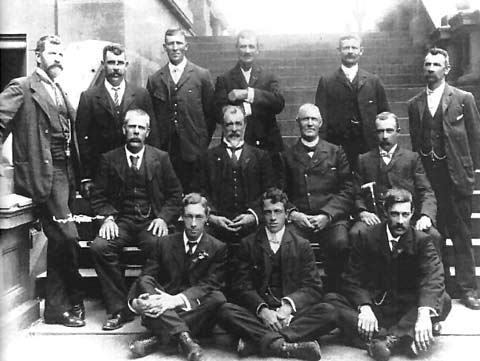
Some of the scullers who attended the Lord Mayor's reception to George Towns in 1902
Back row (left to right): E Laycock, J Stanbury, H Pearce Jnr, H Pearce, C Nielsen, P Kemp. Middle row: W Beach, M Rush, E Trickett, G Towns. Front row: C Towns, C A Messenger, A Towns.
Having worked for Ayling and Sons in England, Towns now established his own scull and oar making business. He defended his title against Richard Tressider in 1904, winning by 20 lengths, but was beaten narrowly by Stanbury, the former champion, in 1905. He regained the title twelve months later, beating Stanbury by 25 lengths. Edward Durnan of Canada was the next challenger and Towns easily disposed of him. He then retired, handing the title to his brother Charles by refusing to accept a challenge from him.
William Webb promptly defeated the new champion and took the title to New Zealand. After defeating Tressider, Webb lost the title in 1908 to Richard Arnst, a New Zealand professional cyclist-turned sculler and Arnst beat him again in a return event. George Towns himself journeyed to England in 1908 to race and be beaten easily by Ernest Barry for the championship of England. In 1910, Barry arranged a match with Arnst for the title, the location being the Zambesi River in Rhodesia. Arnst retained the title and took the winner's money of ₤750.
Minor professional sculling continued in NSW, with several amateurs, including Delofski and Green, turning professional. Great interest, too, was shown in a handicap race for scullers over 50 held in August, 1906. Hard training took place, with Peter Kemp winning the £100 prize from scratch before a crowd of some 20,000 people. Elias Laycock was second and Bill Beach third. A meeting of scullers drew up new rules for the sculling championship of Australia in 1908, and Ben Thoroughgood of Stockton and then Harry Pearce held the title. In 1910, the "Parramatta Hundred", a handicap sculls for £100 prize money, was conducted.
